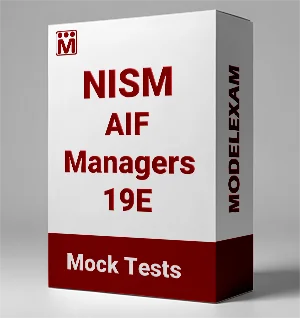NISM Series XIX E : Category III Alternative Investment Fund Managers Certification Examination
NISM Series XIX-E Mock Test
(Free Demo & Premium)

It's Series 19E. 'XIX' is Roman Numeral for 19.
Official name is NISM Series XIX-E: Category III Alternative Investment Fund
Managers Certification Examination. Also known as NISM 19E, NISM XIX-E, AIF
Manager (Cat 3) exam, etc.
This exam creates a common minimum knowledge benchmark for Category III AIF Managers and
their investment teams. It focuses on features of AIF products, valuation norms,
governance, performance measurement, taxation, and regulations specific to Category III
AIFs.
An AIF Manager is a person or entity responsible for managing AIFs (funds investing in
assets outside traditional stocks/bonds like PE, VC, Real Estate, etc.).
- Fund Managers and Investment Professionals of Cat III AIFs.
- Investment Advisors advising on Cat III AIFs.
- Compliance Officers and Legal Advisors.
- Senior Management of AIF/PMS firms.
- Aspiring AIF Managers.
Study Material: Click here for NISM 19E Study Material
Exam Registration: NISM Registration Procedure
Exam Dates: NISM Exam Dates
Assessment Structure
| Total Marks | 100 |
|---|---|
| Total Questions | Multiple Choice [60 x 1 = 60] Case-based [4 cases x 5 marks = 40] |
| Total Duration | 2 Hours |
| Passing Score | 60% |
| Negative Marking | 25% (0.25 mark) |
Syllabus & Weightage
| Chapter No. | Chapter Name | Weightage |
|---|---|---|
| 1, 2, 3 | Inv. Landscape, Types, Modern Portfolio Theory | 3% |
| 4 | AIFs in India & its Suitability | 3% |
| 5 | AIF Ecosystem | 5% |
| 6 | AIF Structuring | 10% |
| 7 | Fee Structure and Fund Performance | 10% |
| 8 | Indices and Benchmarking | 4% |
| 9 | Legal Documentations and Negotiations | 8% |
| 10 | Investment Strategies | 12% |
| 11 | Governance of Funds and Due Diligence | 7% |
| 12 | Valuation | 10% |
| 13 | Fund Monitoring, Reporting and Exit | 10% |
| 14 | Taxation | 8% |
| 15 | Regulatory Framework | 10% |
Detailed Syllabus
Section A: Basics of Investments
Chapter 1: Investments Landscape
Define Investment vs Speculation
Risk Types: Business, Financial, Liquidity, Market, Reg Risk
Risk vs Return relationship
Indian Securities Markets Overview
Chapter 3: Modern Portfolio Theory
MPT Framework, Assumptions, Efficiency Frontier
Capital Market Theory, CAPM, Beta
Chapter 2: Types of Investments
Traditional vs Alternate Investments
Types: VC, PE, Hedge Funds, Real Estate, Distressed
Channels: Direct / MF / PMS / AIF
Section B: Understanding the AIF Ecosystem
Chapter 4: AIF in India & Suitability
Categories I, II, III; Suitability
Portfolio Diversification, Alpha/Beta Management
Chapter 5: AIF Ecosystem
Players: Investors, Sponsors, Trustees, Managers
Providers: Admins, Custodians, Valuers
Concepts: Drawdown, Waterfall, Hurdle Rate, Carry
Chapter 6: AIF Structuring
Pooling, Jurisdiction, Trust/LLP/Company
Unified, Master-Feeder Structures
Chapter 7: Fee & Performance
Management/Incentive Fees, High Watermark
Risk: Standard Deviation, Drawdown, VaR
Returns: IRR, TVPI, DPI, KS-PME, MOIC, Sharpe
Chapter 8: Indices & Benchmarking
Index Types, Methodologies
Stock/Bond Indices, Benchmarking for AIFs
Chapter 9: Legal Documents
PPM, Trust Indenture, Subscription Agreement
Support Service Agreements
Section C: Managing AIF Investments - Cat III
Chapter 10: Investment Strategies
Long-only, Long/Short, Market Neutral
Global Macro, Arbitrage, Event Driven
Using Derivatives for Hedging/Leverage
Chapter 12: Valuation
Approaches, NAV, Third Party Valuers
Chapter 11: Governance & DD
Investee Company DD, Manager Selection DD
Fund Governance, Investor Rights, Conflicts of Interest
Chapter 13: Monitoring & Exit
Periodic Reporting, Exit Options, Winding up
Section D: Taxation & Regulatory
Chapter 14: Taxation
Tax Pass-through, Trust/LLP Taxation
Categories I/II vs III Tax treatment
Chapter 15: Regulatory Framework
SEBI (AIF) Regulations 2012 key provisions